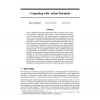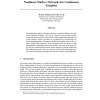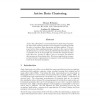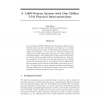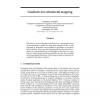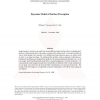102
click to vote
NIPS
1997
15 years 2 months ago
1997
Severe contamination of electroencephalographic (EEG) activity by eye movements, blinks, muscle, heart and line noise is a serious problem for EEG interpretation and analysis. Rej...
101
click to vote
NIPS
1997
15 years 2 months ago
1997
Most computational engineering based loosely on biology uses continuous variables to represent neural activity. Yet most neurons communicate with action potentials. The engineerin...
102
click to vote
NIPS
1997
15 years 2 months ago
1997
We address the problem of learning structure in nonlinear Markov networks with continuous variables. This can be viewed as non-Gaussian multidimensional density estimation exploit...
NIPS
1997
15 years 2 months ago
1997
Active data clustering is a novel technique for clustering of proximity data which utilizes principles from sequential experiment design in order to interleave data generation and...
NIPS
1997
15 years 2 months ago
1997
An asynchronous PDM (Pulse-Density-Modulating) digital neural network system has been developed in our laboratory. It consists of one thousand neurons that are physically intercon...
104
click to vote
NIPS
1997
15 years 2 months ago
1997
The initial activity-independent formation of a topographic map in the retinotectal system has long been thought to rely on the matching of molecular cues expressed in gradients i...
NIPS
1997
15 years 2 months ago
1997
Image intensity variations can result from several different object surface effects, including shading from 3-dimensional relief of the object, or paint on the surface itself. An ...
NIPS
1997
15 years 2 months ago
1997
Conditioning experiments probe the ways that animals make predictions about rewards and punishments and use those predictions to control their behavior. One standard model of cond...
NIPS
1997
15 years 2 months ago
1997
There is strong evidence that face processing is localized in the brain. The double dissociation between prosopagnosia, a face recognition deficit occurring after brain damage, a...
134
click to vote
NIPS
1997
15 years 2 months ago
1997
There are many applications in which it is desirable to order rather than classify instances. Here we consider the problem of learning how to order, given feedback in the form of ...

